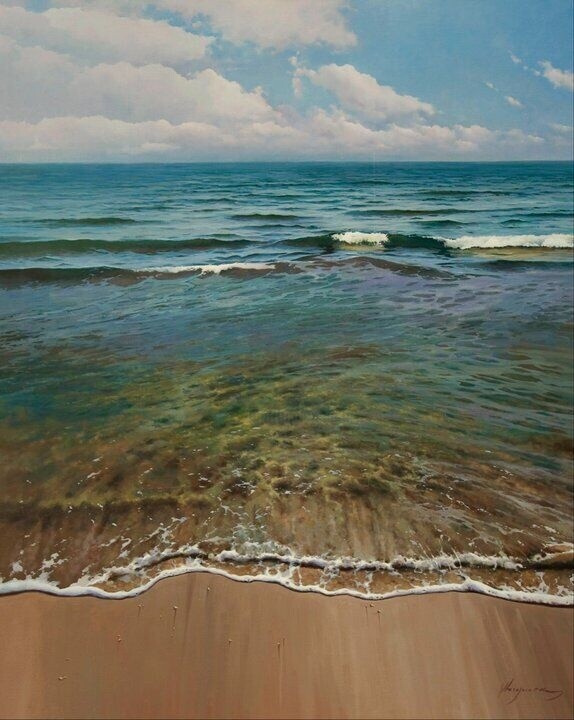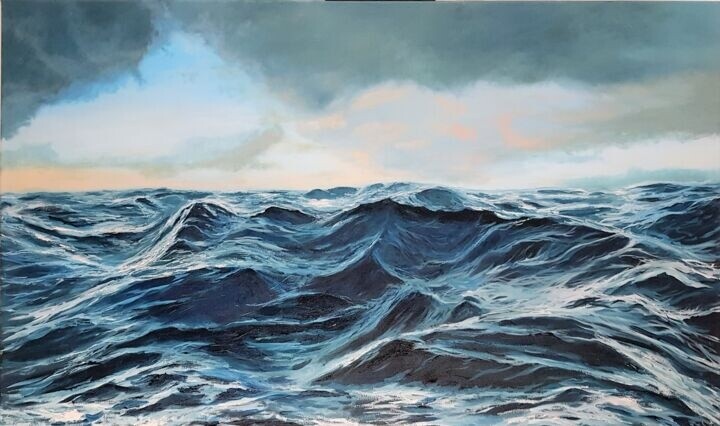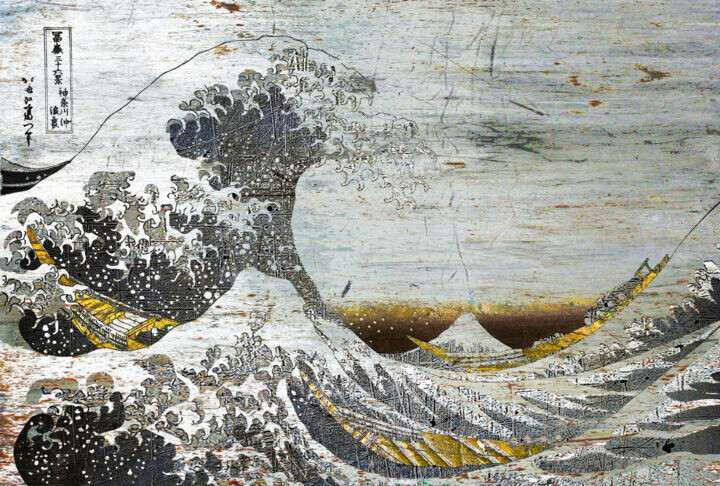 Irina Laube, At the North sea, 2021. Acrylic on canvas, 50 x 50 cm.
Irina Laube, At the North sea, 2021. Acrylic on canvas, 50 x 50 cm.
The seascape genre
Seascape is defined as: a painting, print or even a photograph, aimed at portraying the sea as the main subject of the work, putting in second floor, the human figure, boats or other subjects. "Maritime" paintings, on the other hand, represent that type of figurative production which, although set at sea, emphasizes more the presence of ships or other more or less artificial subjects. It was precisely the latter genre that first became established within the history of art, allowing, at a later stage, the affirmation and development of the other. Examples of the earliest "maritime" works are the rock paintings depicting boats, preserved in the Gobustan State Reserve (Azerbaijan), and the Mermaid Vase, which, dating from the period of classical Greece, depicts Odysseus tied to the mast of his ship, intent on resisting the song of the Sirens. As for the medieval world, however, noteworthy is the Bayeux Tapestry, which, completed in the 11th century, illustrates the events surrounding the Norman conquest of England (1066).
 Mermaid Vase, about 480 BC. - 470 BC.
Mermaid Vase, about 480 BC. - 470 BC.
 Joseph Mallord William Turner, Seascape with Storm Coming On, about 1840. Oil on canvas, 91.4 × 121.6 cm.
Joseph Mallord William Turner, Seascape with Storm Coming On, about 1840. Oil on canvas, 91.4 × 121.6 cm.
Subsequently, it is worth highlighting how, starting in the Renaissance, although it was still rare to see a painting with the sea as its main subject, seascapes began to gain in popularity. This change was mainly linked to the interest that Flemish painting had in the aforementioned theme, as evidenced by the work of the likes of Joachim Patinir, a pioneer of the landscape as an independent genre. However, the definitive establishment of the theme occurred in 1790, the year in which, most likely, the term "seascape" was coined, in order to refer to all those paintings, which, unlike landscape art focused on terrestrial scenery, favored seascapes. Just from this time onwards there have been numerous, and decisive in the history of art, works belonging to the aforementioned genre, such as, for example: Seascape with Storm Coming On (1840) by Joseph Mallord William Turner, The Cliffs at Etretat (1855) by Claude Monet, Seascape, by Joaquin Sorolla, (1904), Seascape (with Olive Clouds) (1969) by Gerhard Richter.
 Jose Higuera, The Other Mediterranean. Oil on canvas, 116 x 81 cm.
Jose Higuera, The Other Mediterranean. Oil on canvas, 116 x 81 cm.
 Marina Zotova, Restless ocean, 2021. Oil on canvas, 120 x 90 cm.
Marina Zotova, Restless ocean, 2021. Oil on canvas, 120 x 90 cm.
Giovanni Fattori and the sea: a particular love story
Among all the artists who depicted the sea, moved by a great attraction and interest towards it, it is important to mention Giovanni Fattori, major exponent of the Macchiaioli movement, who was definitely enchanted, and enraptured, by the sea of his hometown, namely Livorno (Tuscany, Italy). In fact, for the Tuscan, the aforementioned seascape was one of the most investigated subjects, so much so that only this type of his artistic production, would be able to summarize, and synthesize, the entire artistic career of the Macchiaioli master. Fattori was quite aware of this thematic recurrence, so much so that, in his autobiographical writings, he described himself as: a "meticulous observer of the sea, in all its phases, for I love the sea because I was born in a seaside town." In this context, the painting Libecciata perfectly sums up the love nurtured by the master for the peculiarities of the seascape of his Livorno; in fact, the very title of the work alludes to the "libeccio", that is typical strong wind of the Labronian cosca that, coming from the southwest and blowing especially in the summer, is capable of shaking, both the sea and its neighboring vegetation.
 Giovanni Fattori, La libecciata, 1880-1885 circa. Oil on panel, 28.5 x 68 c. Gallery of Modern Art, Palazzo Pitti: Florence.
Giovanni Fattori, La libecciata, 1880-1885 circa. Oil on panel, 28.5 x 68 c. Gallery of Modern Art, Palazzo Pitti: Florence.
In particular, this painting from the 1880s, now housed in the Modern Art Gallery of Palazzo Pitti in Florence, depicts a stretch of coastline of the Antignano shoreline, a district just south of Livorno, later incorporated by the city during the urban expansion of the twentieth century. Therefore, at the time of the artist, this village, carved out between the ramparts of an old Medici fortress around the small church of Santa Lucia, was a quiet place where he often went to paint. In addition, the very stretch of coastline from Antignano to Castiglioncello is, to this day, considered one of the most beautiful in Tuscany. Finally, in this very shoreline of Livorno, still rich with painters who paint the sea from life, we can imagine seeing the Macchiaioli master, intent on immortalizing the motions of the salt water, reflected in those of a tamarisk.
 Mantas Naulickas, Sea mountains, 2022. Oil on canvas, 60 x 100 cm.
Mantas Naulickas, Sea mountains, 2022. Oil on canvas, 60 x 100 cm.
 Peter Nottrott, Seascape sailing impressions XXXL1, 2021. Acrylic on canvas, 150 x 240 cm.
Peter Nottrott, Seascape sailing impressions XXXL1, 2021. Acrylic on canvas, 150 x 240 cm.
Love for the sea continues in contemporary art
The seascape genre, aimed at expressing the purest love for the sea, will never fall into disuse, as its "salty" subject matter is indelibly linked to the deepest memories of our lives, that is, to those particular moments when, the motions of the water mirrored those of our soul. This thought, very much in line with Romantic poetics, continues to fascinate contemporary art, the production of which turns out to be, at times, also a cross-reference to that of the best-known masters of all time. Example of the above can be found in the work of Artmajeur artists, such as, for example, the paintings of Tony Rubino, Alexandra Djokic and Andreas Claußen.
 Tony Rubino, Great wave japanese outline hokusai metallic, 2022. Acrylic / lithograph on canvas, 40, 6 x 61 cm.
Tony Rubino, Great wave japanese outline hokusai metallic, 2022. Acrylic / lithograph on canvas, 40, 6 x 61 cm.
Tony Rubino: Great wave japanese outline hokusai metallic
Great wave japanese outline hokusai metallic is an innovative mixed media painting, aimed at combining the peculiarities of acrylic and lithography, in a composition in which the black and white of the waves triumph, along with the yellow of the boats and the horizon. Precisely in this surreal chromatic context, it is worth noting how, despite the presence of boats, the real protagonist of the work is the sea, which, captured in all its violence, well exemplifies the seascape genre. This composition faithfully reproduces, mixed technique and colors used aside, the masterpiece of the Japanese master Kanagawa Hokusai, namely the woodcut entitled The Great Wave off Kanagawa (ca. 1830-31). The latter work represents one of the most well-known images of Western culture, within which the sea area depicted is part of today's Kanagawa Prefecture, while the mountain in the background is Mount Fuji. Therefore, Tony Rubino has personally interpreted an iconic woodcut, which is certainly capable of strongly reaffirming within contemporary art the popularity of the seascape genre.
 Alexandra Djokic, Water reflection, 2022. Acrylic on linen canvas, 110 x 160 cm.
Alexandra Djokic, Water reflection, 2022. Acrylic on linen canvas, 110 x 160 cm.
Alexandra Djokic: Water reflection
Celebrating the sea also means immortalizing only its surface, enhancing its motions, the smallest currents and the great chromatic variability. What has been said is well exemplified by Alexandra Djokic's painting, where the foreground of an expanse of water is divided into areas of color, which "evolve" from dark blue, to green and light blue, enriched and interspersed with small spots, lines and reflections of brown, reddish and white tones. Most likely, this careful focus on the "vitality" of the sea, could refer to the lithograph of the famous Latvian-American visual artist Vija Celmins, who, titled Ocean Surface Woodcut (1992), eliminated horizons or any other central point of reference, highlighting only the details of the saltwater surface.
 Andreas Claußen, Seascape 2021-07-23, 2021. Oil on canvas, 120 x 120 cm.
Andreas Claußen, Seascape 2021-07-23, 2021. Oil on canvas, 120 x 120 cm.
Andreas Claußen: Seascape 2021-07-23
Andreas Claußen's artistic production, just as in the case of Seascape 2021-07-23, repurposes the seascape genre, which, realistically executed, is mainly aimed at capturing the contrast between salt water and the rocky surface of rocks. Such figurative investigation is reminiscent of the work of the great Impressionist Claude Monet, who, oftentimes, immortalized seascapes marked by the presence of elegant and large "boulders." Examples of this genre are some famous paintings by the French master, such as: The Manneporte in Étretat (1883), Cliffs near Dieppe (1882) and Wild Coast at Belle-Ile (1886). Regarding the first masterpiece, this seascape depicts the largest among the gates of the well-known Normandy coast, where the waves crash, leaving a glimpse of two tiny human figures, literally overwhelmed by the grandeur, and power, of nature. Thus, the Artmajeur artist's work, which tends to analyze "rocky seascapes," is part of a grandiose artistic tradition, to say the least, in which the majesty of the landscape takes precedence over any other subject.


 Olimpia Gaia Martinelli
Olimpia Gaia Martinelli























